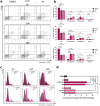Tetrahydroquinolinone derivatives exert antiproliferative effect on lung cancer cells through apoptosis induction
- PMID: 36352170
- PMCID: PMC9646836
- DOI: 10.1038/s41598-022-23640-9
Tetrahydroquinolinone derivatives exert antiproliferative effect on lung cancer cells through apoptosis induction
Abstract
The anticancer properties of quinolones is a topic of interest among researchers in the scientific world. Because these compounds do not cause side effects, unlike the commonly used cytostatics, they are considered a promising source of new anticancer drugs. In this work, we designed a brief synthetic pathway and obtained a series of novel 8-phenyltetrahydroquinolinone derivatives functionalized with benzyl-type moieties at position 3. The compounds were synthesized via classical reactions such as nucleophilic substitution, solvent lysis, and condensation. Biological evaluation revealed that 3-(1-naphthylmethyl)-4-phenyl-5,6,7,8-tetrahydro-1H-quinolin-2-one (4a) exhibited potent cytotoxicity toward colon (HTC-116) and lung (A549) cancer cell lines. Analysis of the mechanism of action of compounds showed that compound 4a induced cell cycle arrest at the G2/M phase, leading to apoptotic cell death via intrinsic and extrinsic pathways. Taken together, the findings of the study suggest that tetrahydroquinolinone derivatives bearing a carbonyl group at position 2 could be potential lead compounds to develop anticancer agents for the treatment of lung cancers.
© 2022. The Author(s).
Conflict of interest statement
The authors declare no competing interests.
Figures







Similar articles
-
Biological Activity, Apoptotic Induction and Cell Cycle Arrest of New Hydrazonoyl Halides Derivatives.Anticancer Agents Med Chem. 2019;19(9):1141-1149. doi: 10.2174/1871520619666190306123658. Anticancer Agents Med Chem. 2019. PMID: 30843494
-
Simple 2(5H)-furanone derivatives with selective cytotoxicity towards non-small cell lung cancer cell line A549 - Synthesis, structure-activity relationship and biological evaluation.Eur J Med Chem. 2018 Apr 25;150:687-697. doi: 10.1016/j.ejmech.2018.03.021. Epub 2018 Mar 10. Eur J Med Chem. 2018. PMID: 29571156
-
Discovery of novel 4(1H)-quinolone derivatives as potential antiproliferative and apoptosis inducing agents.Bioorg Med Chem Lett. 2017 Sep 1;27(17):4185-4189. doi: 10.1016/j.bmcl.2017.07.005. Epub 2017 Jul 5. Bioorg Med Chem Lett. 2017. PMID: 28757067
-
Design, synthesis, in vitro antiproliferative activity and apoptosis-inducing studies of 1-(3',4',5'-trimethoxyphenyl)-3-(2'-alkoxycarbonylindolyl)-2-propen-1-one derivatives obtained by a molecular hybridisation approach.J Enzyme Inhib Med Chem. 2018 Dec;33(1):1225-1238. doi: 10.1080/14756366.2018.1493473. J Enzyme Inhib Med Chem. 2018. PMID: 30141353 Free PMC article.
-
A New Series of Triazolothiadiazines as Potential Anticancer Agents for Targeted Therapy of Non-Small Cell Lung and Colorectal Cancers: Design, Synthesis, In silico and In vitro Studies Providing Mechanistic Insight into Their Anticancer Potencies.Med Chem. 2021;17(10):1104-1128. doi: 10.2174/1573406416666201021142832. Med Chem. 2021. PMID: 33087032
Cited by
-
Synthesis, characterization and biological research of novel 2-(quinoline-4-carbonyl)hydrazide-acrylamide hybrids as potential anticancer agents on MCF-7 breast carcinoma cells by targeting EGFR-TK.RSC Adv. 2024 Jul 26;14(32):23495-23504. doi: 10.1039/d4ra03963g. eCollection 2024 Jul 19. RSC Adv. 2024. PMID: 39071480 Free PMC article.
-
Meldrum's acid assisted formation of tetrahydroquinolin-2-one derivatives a short synthetic pathway to the biologically useful scaffold.Sci Rep. 2024 Jan 4;14(1):487. doi: 10.1038/s41598-023-50535-0. Sci Rep. 2024. PMID: 38177152 Free PMC article.
References
-
- Beberok A, et al. Ciprofloxacin triggers the apoptosis of human triple-negative breast cancer MDA-MB-231 cells via the p53/Bax/BCL-2 signaling pathway. Int. J. Oncol. 2018;52:1727–1737. - PubMed
MeSH terms
Substances
LinkOut - more resources
Full Text Sources
Medical

